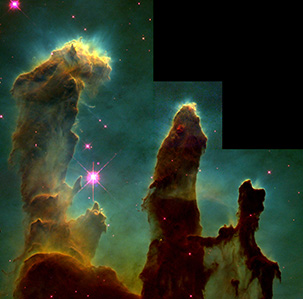The 'Pillars of Creation' Across Light and Time
'Pillars of Creation' Over Time
Credit: 1995: Optical: NASA/ESA/STScI/ASU/J.Hester & P.Scowen; 2015/2018:
X-ray: NASA/CXC/INAF/M.Guarcello et al., Optical: NASA/STScI; 2023/2024: X-ray: NASA/CXO/SAO,
Infrared: NASA/ESA/CSA/STScI, Image processing: L. Frattare;
Sonification: NASA/CXC/SAO/K.Arcand, SYSTEM Sounds (M. Russo, A. Santaguida)

1995 Hubble Space Telescope Image of
the 'Pillars of Creation'
Credit: NASA, ESA, Jeff Hester, and Paul Scowen (Arizona State University)
Nearly 30 years ago, in 1995, NASA’s Hubble Space Telescope captured an image that would become one of the most recognizable in astronomy: towering columns of gas and dust in the Eagle Nebula, sculpted by intense stellar winds and radiation. Dubbed the “Pillars of Creation,” this image reshaped how we visualize star formation, appearing everywhere from textbooks to T-shirts.
But the story of the Pillars didn’t end there. Over the decades, astronomers have returned to this region with Hubble and more telescopes, peeling back new layers of its story. Earlier in its mission, NASA’s Chandra X-ray Observatory looked for the high-energy signatures of young stars inside the Pillars themselves, revealing that massive newborn stars—thought to be actively forming inside the Pillars—were surprisingly absent. This raised the question: are the Pillars past their star-forming prime since young stars are usually strong X-ray sources? Chandra's sharp X-ray vision does allow it to identify hundreds of very young stars in the region and others still in the process of forming (known as "protostars").
More recently, NASA’s James Webb Space Telescope captured the Pillars in infrared light, cutting through dense clouds of dust to expose intricate details of their inner workings. Webb’s data showed vibrant new stars forming at the tips of the Pillars, confirming that star birth is indeed ongoing. The combined perspectives from Hubble, Chandra, Webb, and other observatories give us a more complete view of this stellar nursery than ever before.
As we mark three decades since Hubble’s first glimpse of the Pillars of Creation, we celebrate not just a single image but an evolving scientific story—one that will continue to unfold with the next generation of space telescopes. What new secrets will they reveal?
For those who want to experience the Pillars of Creation in new and immersive ways, explore our resources, including sonifications that transform astronomical data into sound, 3D prints and visualizations that bring these structures to life, and multiwavelength images that reveal different aspects of this iconic region. Discover more at Chandra’s Pillars of Creation resource page.
